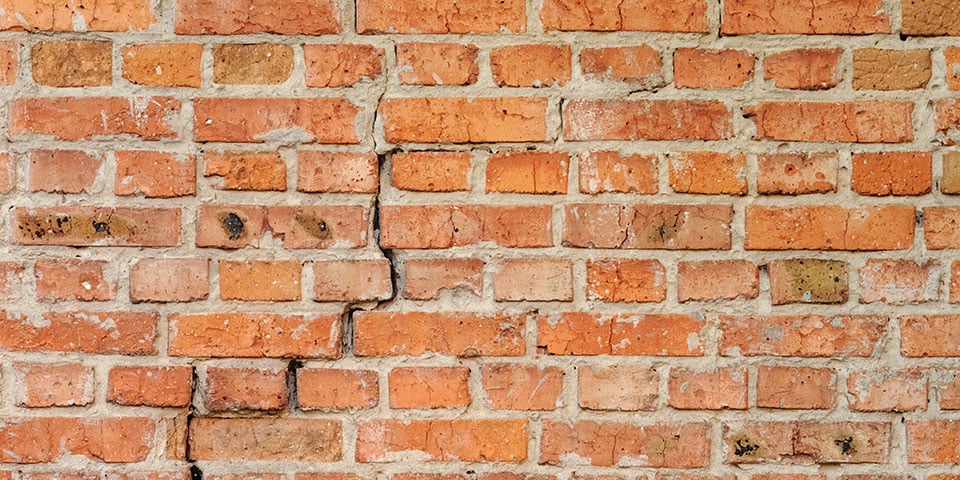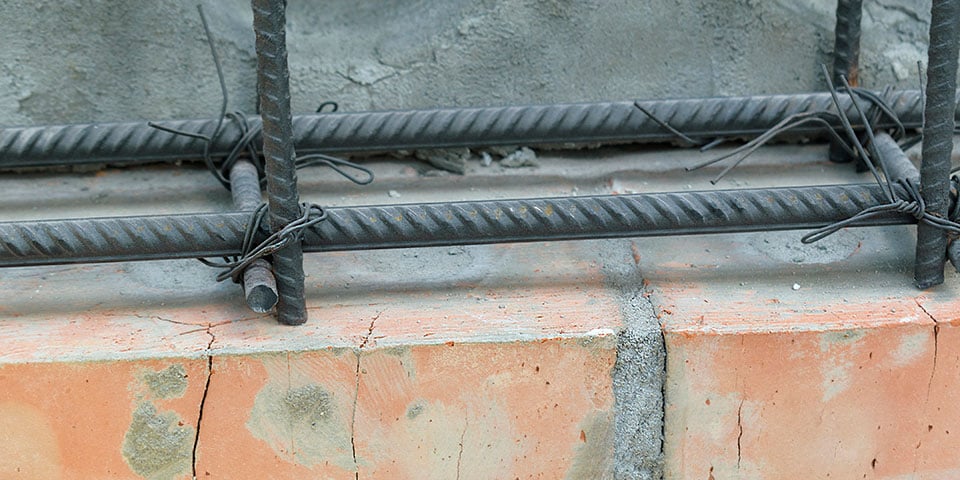How To Repair Brick Wall Damage

Bricks might seem like they will last forever, but there are many ways a brick wall can deteriorate. Extreme temperatures, freeze/thaw cycles, exposure to precipitation, or even a shift in your foundation can cause damage to your home’s brickwork. Sometimes this damage can turn from a quick and easy fix into a structural fiasco that requires extensive remediation if left unrepaired.
Brick walls can suffer problems ranging from cracks to areas of deterioration in the mortar joints and on the brick itself. Some problems are more severe than others. While a crack in your brick wall does not always lead to weather or structural damage, it does ruin the aesthetic. Deterioration from spalling can lead to more damage over time and, eventually, could result in needing to replace your brick wall. Need more bricks or supplies to patch up your home and restore your aesthetic? Contact Batchelder & Collins at 757-625-2506!
Can Brick Walls Be Repaired?
Generally speaking, brick walls are easy to repair. Most cracks in brick walls are cosmetic and fixable. These cracks occur due to exposure to extreme temperatures and sudden exposure to hot or cold. Cosmetic cracks are not a big problem when they first appear, but they can become a problem if left unaddressed.
Structural cracks, which run deep and threaten the structure’s integrity, are a serious problem. Structural cracks often appear after an earthquake or over time from poor structural design. Like cosmetic cracks, structural cracks get worse over time.
A Summary of the Brick Wall Repair Process
Repairs vary depending on where the crack is as well as the cause of the crack. However, a summarized version of the step-by-step procedure for repairing old brick is below:
- Remove the cracked mortar from the wall. On horizontal joints, use a raking bar to remove mortar to a depth of 2 centimeters. On vertical joints, use a chisel and hammer.
- Get rid of excess mortar. Remove the remaining loose mortar with a wire brush.
- Spray the old mortar with water. Do this because a dry brick wall absorbs too much water.
- Patch with mortar. Fill the loose joints with new mortar. Use a jointer brush. Don’t leave voids!
- Point the wall. Use the pointer to flatten the mortar in the joint.
What If the Brick is Crumbling?
What if the brick wall is crumbling instead of cracking? Can it be repaired? The quick answer to this question is yes; you can repair a crumbling brick wall. When the brick is crumbling, we call this spalling. Two events can cause spalled brick:
- Someone replaced old mortar with new mortar. Mortar must be softer than brick. Compared to modern walls, historic brick walls were built with a softer type of brick and softer mortar mix made from lime. Modern walls are made from much harder bricks, while most mortar is made from the relatively hard Portland mortar mix. Sometimes, you’ll find spalling on a historic brick wall because someone repaired the wall with a harder, modern mortar mix.
- Moisture became trapped in the brick. If someone sealed the brick, this might have trapped moisture. Freeze/thaw cycles will cause the moisture in the brick to eventually expand within the brick, causing the face of the brick to pop off.
If your brick wall is crumbling or spalling, call a professional to solve this problem.
What Causes Cracks in Brick Walls?
Cracks develop in brick foundations for many reasons. Knowing the causes can help you avoid these problems in your walls and may help you identify problems in their early stages.
Weather
Climate and weather play a big role in the lifespan of a brick wall. Brick and mortar are both porous, and brick can absorb water from precipitation. When freeze/thaw cycles occur, water damage can compromise the brick and mortar’s structure by washing away the sediment that gives the brick its structural integrity. This is a problem in all types of walls, but for anything load-bearing, this can be devastating.
Some homeowners respond to these issues by sealing their bricks to prevent moisture absorption. While this may sound sensible on its front, standard sealant will lock in moisture, exacerbating the wall’s problems. Using brick sealant when treating your load-bearing brick wall, brick chimney, or other brick structure is essential for preventing damage.
Corrosion of Building Supplies
Building supplies don’t last forever. Bricks can become weathered over time, requiring repair mortar and other treatments. Tuckpointing or repointing helps brick walls by restoring grout in bed joints or vertical joints. In addition, bricks aren’t the only building materials that degrade — everything needs repair or replacement eventually, including gutters. Faulty gutters can cause water to overflow onto brick, leading to more moisture absorption than would otherwise occur.
Soil/Foundation
Soils react to moisture when absorbed and dried, but some soil types are far more reactive than others. Clay soil, for example, significantly expands when exposed to moisture. This can cause the foundation to settle, move and crack.
What Types of Damage to a Brick Wall Can Be Repaired?
Whether you can repair a brick wall depends on the type of cracks in the wall.
Location of Brick Damage
You can find brick cracks inside the house, outside the house, and on the foundation walls. Interior wall cracks appear on plasterboard, exterior cracks appear on brick walls outside your house, and foundation cracks are found around the home’s foundation.
Cracks that are not easily reachable and are purely cosmetic may not be worth repairing. However, you must repair some types of cracks (like some cracks in the home’s foundation, for example) to restore structural stability.
Type of Crack in the Brick Wall
You can determine the type of crack your house is experiencing by the direction of the crack. For example, horizontal cracks are caused by the deterioration of building materials and by foundation settlement. These cracks are relatively common and appear in older homes.
Vertical cracks are typical in warm climates and are caused by the expansion of the materials.
Brick veneer cracks are stair-step-shaped cracks that appear between and around bricks. These cracks are a sign of serious structural damage. They need immediate attention from a professional.
Depth of the Crack in the Brick
Structural cracks run deep and are a serious problem, while cosmetic cracks are surface-level. That said, cosmetic cracks may allow moisture into the brick wall, which can cause water damage over time. You may need to repair cosmetic cracks because they can lead to larger structural cracks over time.
How Do I Fix a Damaged Brick Wall?
If you’re wondering how to repair a brick wall, these tips can help.
Safety First
Working with masonry can be dangerous for a variety of reasons. Stone dust can lodge deep in the lungs and cause damage, while bricks themselves are very heavy and can cause back problems over time. Finally, bricks high on the wall may be difficult to reach safely. Working with a professional to get the work done is the best way to ensure safety. However, the step-by-step procedure is below if you decide to do the work yourself.
Apply Mortar
To start, remove any old mortar between the brick, and remove the broken pieces of brick itself. Use a grout saw on small joints and a cold chisel on larger joints. If you’re removing several pieces of brick, start at the top and work your way to lower bricks as you go. Clean out the spaces left by the brick with a wire brush, then wash away the remaining bits.
Mix the mortar according to the manufacturer’s instructions, then apply the mortar with a trowel like you’re buttering bread. Apply about an inch of mortar to the sides and bottom of the opening.
Insert Brick
Insert the brick into the opening and tap the brick into place with the end of your trowel or mallet. Push the brick into the opening until it is flush with the rest of the wall. Remove excess mortar with the side of the trowel, and insert mortar into voids with the trowel.
Cure the Brick
Spray the brick with a mist of water periodically for about three days to help the wall cure properly.
What Tools Will I Need to Fix a Brick Wall?
To repair a brick wall, you’ll need the following tools:
- Stiff bristle brush
- Pointing trowel
- Brick trowel
- Garden hose
- Cold chisel
- Carbide-tipped grout saw
- Engineer’s hammer
- Mallet
- 5-in-1 painter’s tool
Need New Bricks to Keep Your Home Aesthetically and Structurally Sound?
To repair a brick wall, or perform your next brick wall home improvement, get quality tools from a reputable supplier. Batchelder & Collins sells materials that homeowners, contractors, and masons trust. Whether you’re performing a DIY project or you’re a professional with expertise in chimney repair, foundation repair, or another trade, we sell quality materials that can help. Call 757-625-2506 to get started with your project today.
Enjoy Your Backyard All Fall Long

Now is the perfect time to take advantage of autumn’s mild days to prepare your backyard for the cold months ahead. But who’s to say you can’t still enjoy your backyard, spending time with your family, and cooking outdoors all fall long.
"*" indicates required fields




